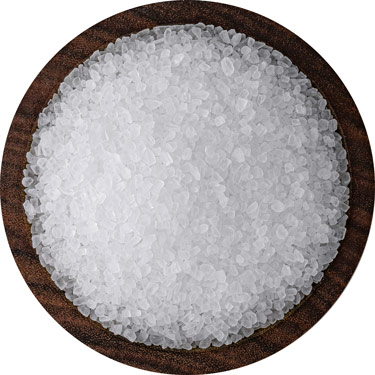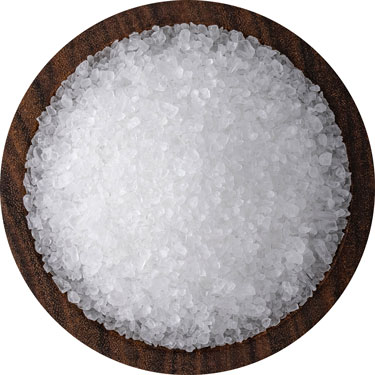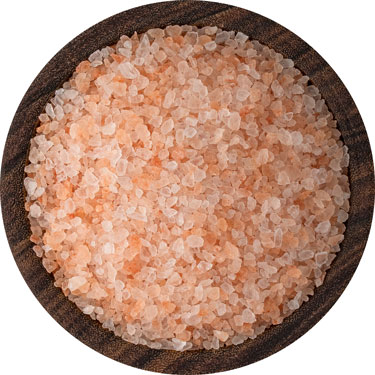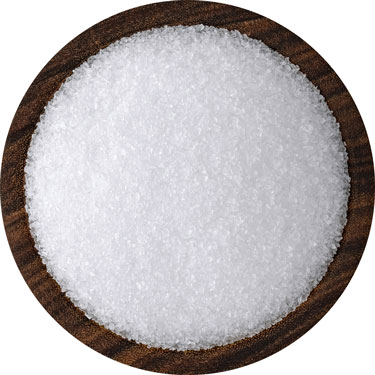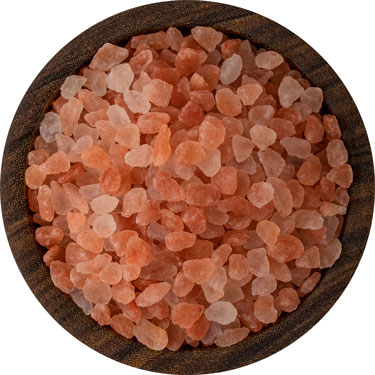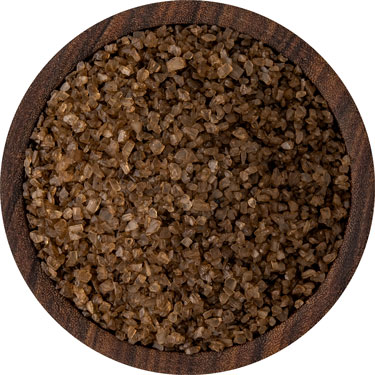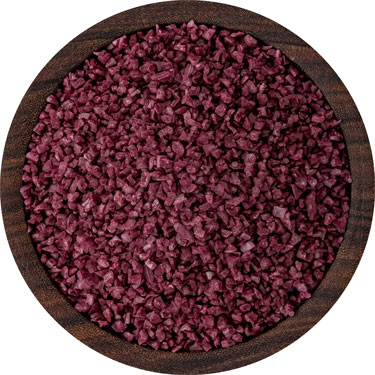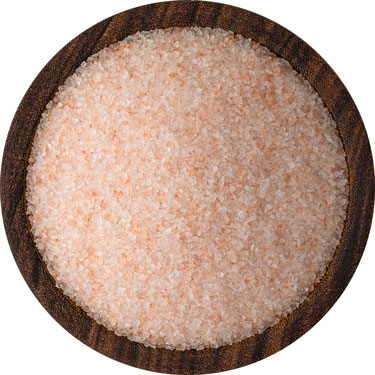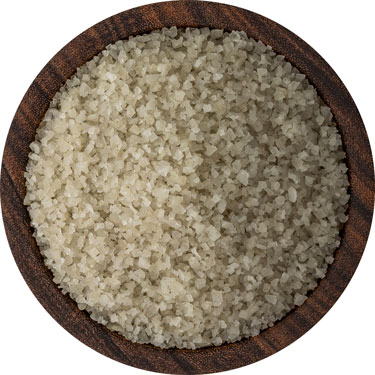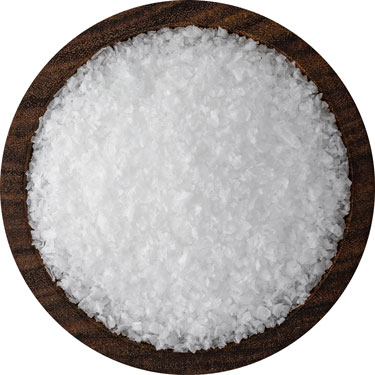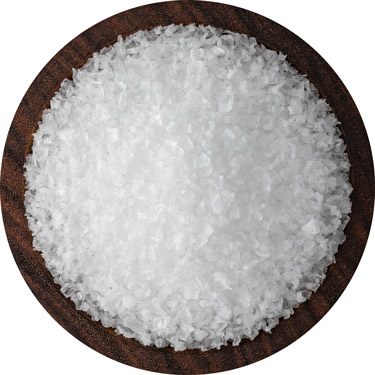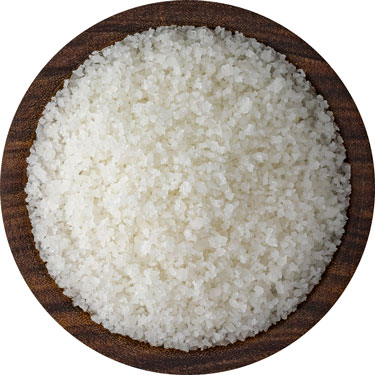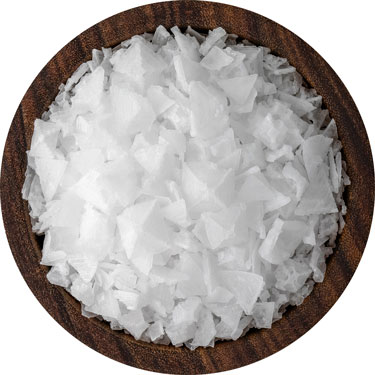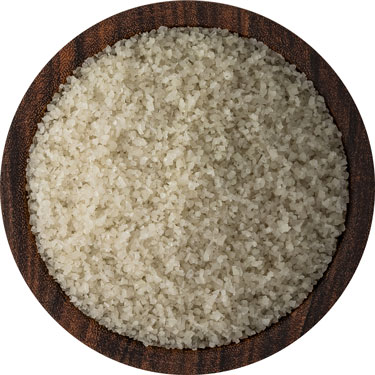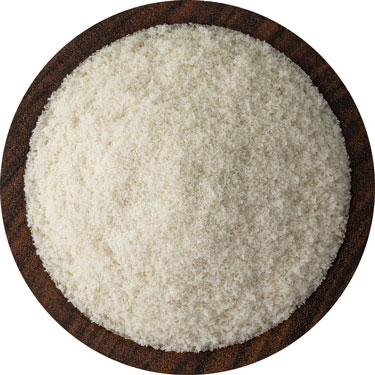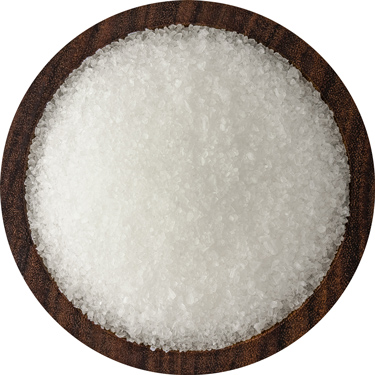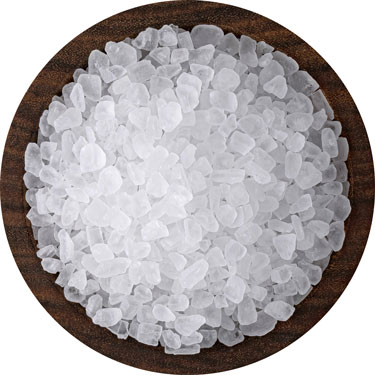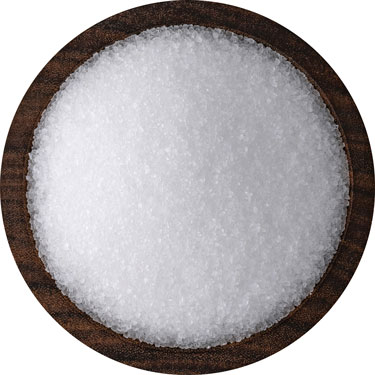Learn more about
- Ocean Salt
- Sea Salt
- Mineral Salt
- Fine Grain Salt
- Coarse Grain Salt
- Smoked Sea Salt
- Flavored Salt
- Himalayan Pink Salt
- Organic Salt
- Kosher Salt
- Pretzel Salt
- Finishing Salt
- Fleur de Sel
- Flake Salt
- Grey Salt
- French Sea Salt
- Mediterranean Sea Salt
- Grinder Salt
- Hawaiian Sea Salt
- Kala Namak
- Table Salt
- Iodized Salt
Ocean Salt
“Ocean salt” refers to salt harvested from the pure, cold waters of our oceans. It is harvested by channeling ocean water into large, clay lined salt marshes, then allowing the sun and wind to evaporate the water naturally. Ocean salt manufacturers typically do not refine ocean salt as much as other kinds of processed salt, so it retains natural traces of other minerals, including iron, magnesium, calcium, potassium, manganese, zinc, and iodine. Proponents of ocean salt rave about its bright, pure, clean flavor as well as the subtleties left by trace minerals. Ocean salt is thought to be healthier and more flavorful than traditional table salt.
Ocean salt is often sourced from the Arctic and the Atlantic Ocean. Available in coarse, fine, and extra fine grain size, and many sizes in between.
Sea Salt
Also known as: Sal del Mar, Sel de Mer, Sale Marino
“Sea salt” is a broad, umbrella term that refers to all unrefined salt derived directly from a living sea or an ocean. It is harvested through the same natural evaporation process as Ocean salt. Sea salt is typically unrefined, so it contains so it retains natural traces of other minerals, depending on the source. For this reason, sea salt is thought to be healthier and more flavorful than traditional table salt.
Some of the most common sources for sea salt include the North Sea and the Mediterranean Sea.
Mineral Salt
Mineral salt, such as Himalayan pink salt, is sourced from salt mines created long ago by ancient oceans and seawater deposits that have long since evaporated. The distinctive colors of this salt, which typically vary from dark red to light pink, are due to natural trace minerals that also give it a more subtle flavor than sea salt. With its unmatched beauty, rosy hue and distinctive flavor, Himalayan pink salt is the most popular mineral salt.
Fine Grain Salt
Also known as: Shaker Salt, Ingredient Salt
Of the many varieties of salt grain sizes, the most common types found in grocery stores are fine and coarse grain. Unlike coarse grain, which requires a grinder or mill, fine grain is the standard size for table salt, ready for daily kitchen use in shakers, seasoning, sautéing or baking.
Coarse Grain Salt
Also known as: Grinder Salt, Mill Salt
Coarse salt refers to larger, standard salt crystals. Most coarse salts are best used in a grinder, providing an easy way of serving up freshly ground sea salt with a meal. Coarse salt tends to be less moisture sensitive than its finer-grained counterparts, so it resists caking, ideal for long term storage. Grind coarse salt over a meal to finish any dish just before serving, or use the large grains to create a salt crust on meat or fish, in brines for pickling, or to add salty flavor to soups, stews, and pasta.
Smoked Salt
Smoked sea salts are a relatively new and exciting gourmet salt option. They add a unique, woodsy flavor to a wide range of dishes, and are delicious for grilling or oven roasting. When considering a smoked sea salt, be sure that it is a naturally smoked salt without additives like liquid smoke flavoring, as this can create a bitter taste. Slow-smoked salts over real American wood planks infuse salt crystals with 100% natural cold smoke, and set the standard for a smoked salt.
Smoked sea salts add an authentic smokehouse flavor to soups, salads, pasta, and sandwiches, and are an absolute must when preparing salmon. Available in fine, coarse, and flake grain sizes.
Flavored Salt
Flavored salts provide an opportunity to get creative with your cooking and experiment beyond traditional pairings. The highest standard of flavored salts bind natural ingredients to individual crystals of sea salt, resulting in a flavor concoction even more impactful than a traditional seasoning blend. Look for flavored salts that use whole ingredients fused with sea salts in a 100% natural process, as artificial flavors and processing techniques do not compare.
Visit our How to Use Flavored Salt guide for tips and recipe suggestions on using our 20+ Fusion flavored salt varieties!
Himalayan Pink Salt
Also known as: Himalayan Rock Salt, Sendha Namak, Pakistani Namak
Beloved for its clean taste, exquisite color, and beneficial minerals, Himalayan pink salt is the most popular mineral salt on the market. Legitimate Himalayan pink salt is a natural phenomenon that exists deep in the Himalayan mountains of Pakistan due to ancient sea beds that crystallized long ago, before modern pollutants existed. Because of this, Himalayan salt is believed to be one of the purest salts on earth. The natural trace minerals result in its range of gorgeous colors, from varying shades of pink to deep red.
Himalayan pink salt can be customized to varying sizes for multiple applications. From fine grain for shakers to coarse grains for grinders or even blocks for salt therapy, Himalayan pink salt is incredibly useful and versatile. It is a popular table salt replacement with a subtle flavor that goes well with any dish, from vegetables and meat to desserts or as a cocktail glass rim. Himalayan pink salt is also suitable for bath and spa use for a hot soak or as an exfoliating scrub.
Learn more about how Himalayan pink salt is processed here.
Organic Salt
As of yet, in the United States, the USDA does not recognize salt as an item that can be certified as organic due to the fact that it contains no carbon compounds. Although salt is not certified organic in the U.S. by the same standards as botanicals, agriculture, or livestock, there are several organizations that have set up rigorous guidelines for the production of salt in their respective countries. These standards ensure the purity of the water, the cleanliness of the salt beds, and that proper techniques are used for harvesting and packaging the salt.
Read on for more information about Organic Salt certifications.
Kosher Salt
The term “kosher salt” can refer to two types of salt. One is a specific shaped flake salt that is so named for its use in the preparation of meat according to the requirements of Jewish dietary guidelines. It contains fewer additives and has a cleaner, more even taste than ordinary table salt. The flakes dissolve easily and have a less pungent flavor than processed table salt. Kosher salt may also refer to a very light, flaky salt with a pyramid-shaped grain. Due to the shape of the granules, there is simply less salt in a pinch of kosher salt than in a pinch of table salt. This is the kind of salt most often used on top of pretzels and on the rims of margarita glasses. It is important to note that all kosher salt is not necessarily sea salt.
For additional information, read our Kosher Salt Guide.
Pretzel Salt
Also known as: Pretzel Grain Salt
Pretzel salt is a medium-to-large crystal, typically with more flat surface area and a translucent appearance that offers a delectable crunch and holds its shape under high heat. Despite its most popular use on pretzels, this variety of salt is also more than suitable in spice blends and rubs, to rim margarita glasses, or on top of dinner rolls, granola bars, and chocolates.
Finishing Salt
Finishing salts are the premier varieties of specialty salts. These fine salts are most often harvested by hand in specific regions of the world, and are most admired for their unique textures, such as moist crystals and delicate flakes. All varieties provide a strong crunch and dissolve quickly, resulting in a burst of clean, intensified flavor with each bite. These salts enhance the depth of natural flavors in any dish and enrich a table setting with beautiful, shimmering presentation. The various colors and flakes of finishing salts make gorgeous garnishes for every meal.
Also see Flake Salt, Fleur de Sel, and French Sea Salt below.
Fleur de Sel
Also known as: Flower of Salt, Flor de Sal (Portuguese)
Rare, delicate Fleur de Sel is the highest standard of finishing salts. Fleur de Sel translates to "Flower of Salt" and is often called the "caviar of salts" by chefs worldwide. True Fleur de Sel comes from the Guérande region of the French Atlantic Coast and is made up of young crystals that form naturally on the surface of salt evaporation ponds. The salt harvesters of the Guérande region, known as paludiers, carefully rake the salt crystals using tranditional wooden tools. The weather conditions must be just right to produce a true Fleur de Sel harvest, and the process can only be completed once a year, during the summer.
Similar to fine wine regions, different areas within Guérande produce salts with their own unique flavors and aroma profiles.
Fleur de Sel is ideal for salads, cooked fresh vegetables, and grilled meats.
Flake Salt
Also known as: Flaky Salt, Flakey Salt
Flake sea salt is a large, light crystal, reminiscent of snowflakes. To create real flake salt, seawater is evaporated using the natural processes of sun and wind, producing salt brine that is fed into an open evaporating pan. The brine is then slowly heated until delicate pyramid-shaped crystals of salt are formed. The finished product is light, flaky sea salt. Flake salts can come in many different sizes, from large pyramid-shaped flakes to paper-thin, delicate flakes.
Grey Salt
Also known as: Sel Gris
Sel Gris, or grey salt, is a moist, unrefined sea salt, comes from the Brittany region of France's Atlantic coast. Its natural light grey color is a result of minerals absorbed from the clay lining of the salt ponds from which it is harvested. The salt is collected by hand using wooden tools and methods dating back to the Iron Age.
Grey salt has gained great fame in the mainstream culinary world in the last few years for its distinct flavor and color. It is available in coarse grain, for finishing or pinching, stone ground fine for use in shakers, and extra fine velvet grain, perfect for sprinkling over nuts or popcorn.
French Sea Salt
French sea salts are hand-harvested from pristine Atlantic seawater. These sea salts are unrefined, meaning that they retain more of the trace minerals that naturally occur in seawater. French Grey Sea Salt, or Sel Gris, s harvested using traditional methods. This painstaking process is done entirely by hand, using only wooden tools. This preserves the pure taste of the French salt and its uniquely moist crystalline texture.
Sel Gris is slightly lower in sodium chloride content than average sea salts, generally containing around 94% sodium chloride, depending on the current harvest. French sea salts are ideal for use on salads, cooked fresh vegetables, and grilled meat. Sel Gris is available in brut or tamisé grains, ideal for pinching or salt cellars, stone ground fine for use in shakers, and extra fine velvet grain, perfect for sprinkling over nuts and popcorn.
Mediterranean Sea Salt
Salt has been harvested from the Mediterranean Sea throughout history. Nearly every country that borders the Mediterranean harvests its salt and it is sold all throughout the world, common in shakers, on snack foods, in frozen meals and prepared foods.
There have been recent food safety concerns about Mediterranean salt.
Grinder Salt
Also known as: Mill Salt
Grinder or mill salt is not specific to any type of salt. The term refers to large, dry salt crystals. A larger size grain is ideal to grind in a mill, and a lower moisture content allows the salt to flow through the grinder with ease. Grinder salt is used for flavoring foods at the table when the host determines that a finer, higher grade finishing salt is not required. It is also appropriate for use during cooking for freshly ground salt flavor.
It is important to always use a salt mill with a ceramic or plastic grinding mechanism. Metal, including stainless steel, will rust and corrode after prolonged contact with salt.
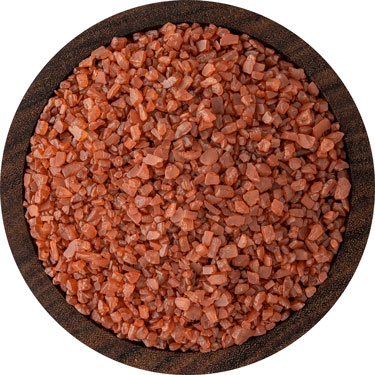
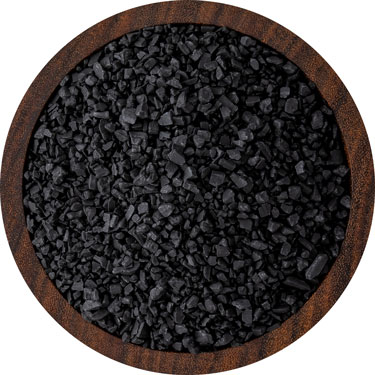
Hawaiian Sea Salt
Also known as: Alaea, Alae, Hawaiian Red Salt, Hiwa Kai, Black Hawaiian Salt
Alaea sea salt is a traditional Hawaiian table salt used to season and preserve. Naturally occurring volcanic red clay called "Alae" is traditionally added to enrich sea salt with trace amounts of iron oxide. This natural additive gives the salt its characteristic red color. The clay imparts a subtle flavor that is more mellow and earthy than regular sea salt. It is the traditional and authentic seasoning for native Hawaiian dishes such as Kalua pig, poke, and Hawaiian jerky. It is spectacular when used on good cuts of meat, such as prime rib and pork loin.
Black Hawaiian sea salt, or Hiwa Kai, contains activated charcoal. This natural addition gives sea salt a unique black color, silky texture, and salient flavor-enhancing properties. Charcoal has become popular for use in detox diets. Though not in large enough quantities to take as a detox supplement, the activated charcoal in Hiwa Kai Black Hawaiian sea salt adds a striking pop of color and tasty flavor to your dishes.
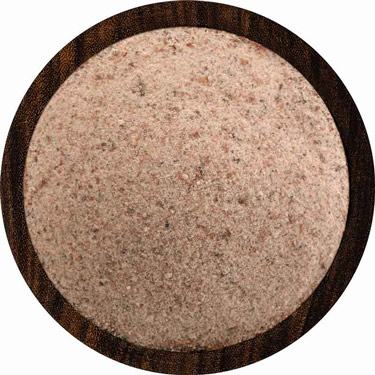
Kala Namak
Also known as: Black Salt, Sanchal
Kala Namak, or Indian black salt, is an unrefined mineral salt. It is actually a pearly, pinkish-gray color rather than black, and has a strong, sulfuric flavor and aroma. Vegan chefs have made this salt popular for adding an egg flavor to dishes like tofu scrambles. Kala Namak is used in authentic Indian cooking and is popular in mango smoothies.
Table Salt
Table salt is the most common kind of salt found in the kitchen. It is not sea or ocean salt, but rock salt, usually found in salt mines. Once mined, it is refined and most minerals are removed until it is pure sodium chloride. The removal of the natural trace minerals creates a more bland and bitter salt than unprocessed varieties, in addition to the loss of potential benefits from trace minerals that the human body needs.
Most table salt is also available in either plain or iodized forms.
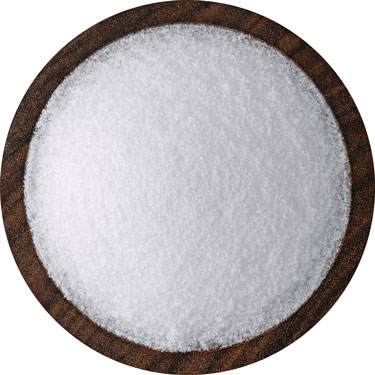
Iodized Salt
American salt manufacturers began iodizing salt by artificially spray coating mineral salt with iodine in the 1920s during The Great Depression, in cooperation with the government. At the time, a significant amount of people in some parts of the country were found to be suffering from goiter, an enlargement of the thyroid gland caused by an easily-preventable iodine deficiency.
Today. we know that most people require less than 225 micrograms of iodine daily. Seafood and many dark greens, as well as sea salt, contain natural traces of iodine, and supplementation is unnecessary if there are sufficient quantities in one's diet.

